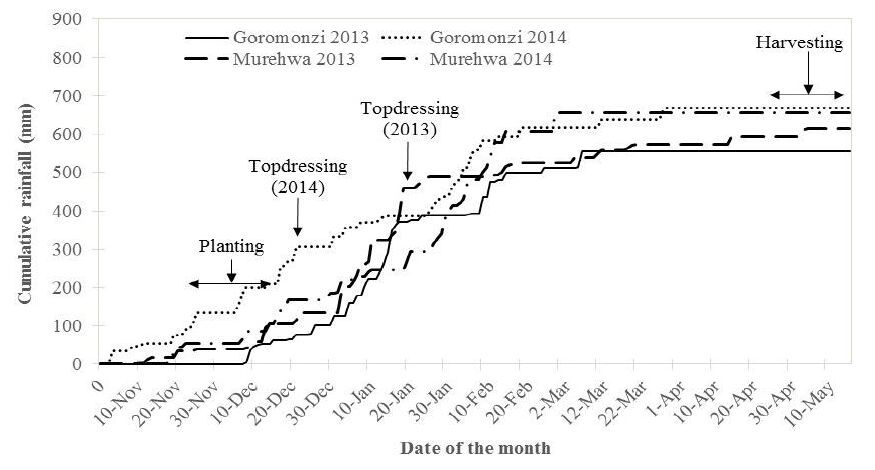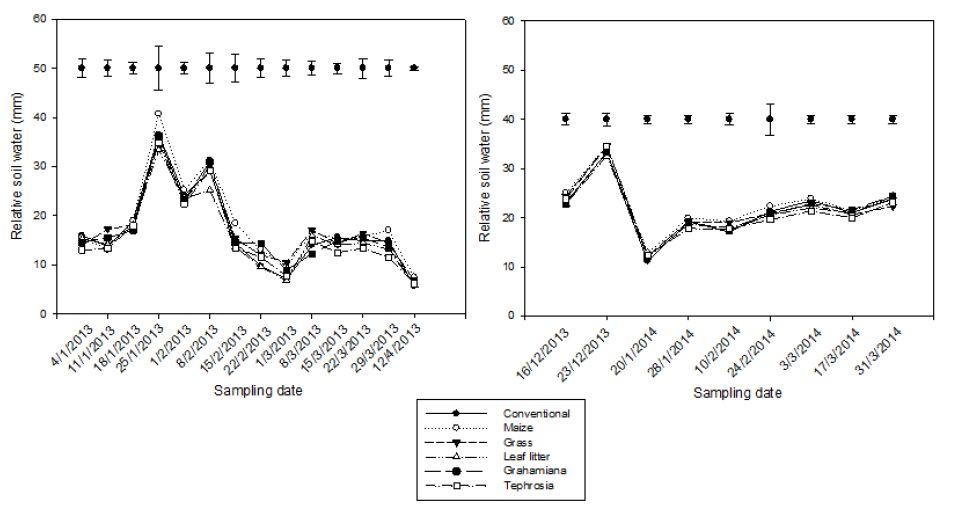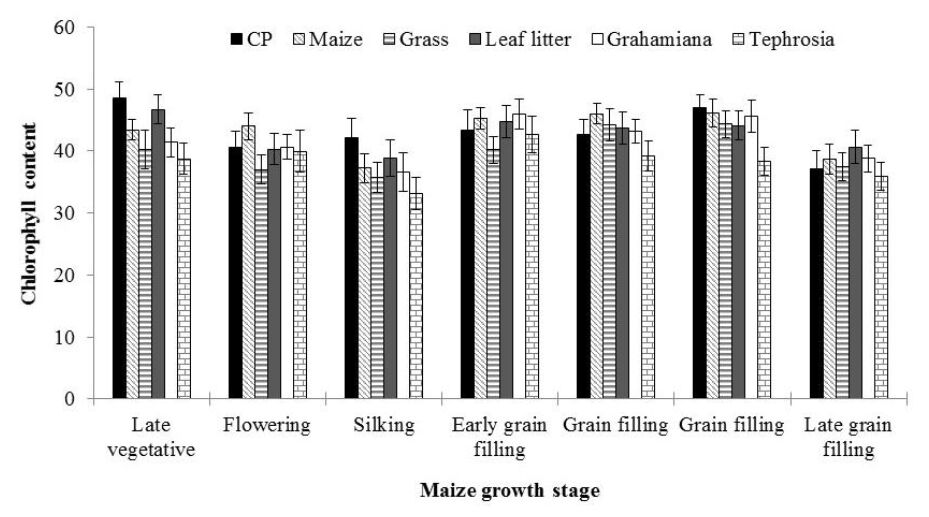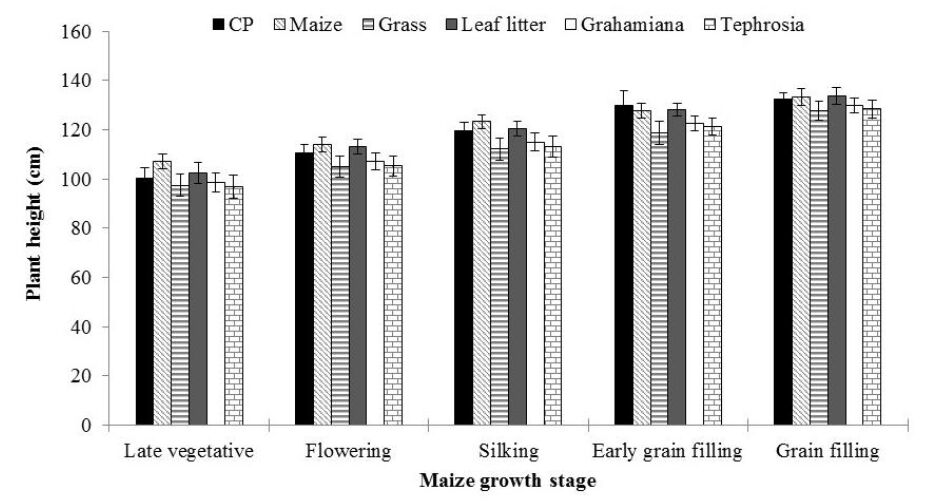1. Introduction
Mixed crop-livestock production characterizes smallholder farming systems in some agro-ecological regions of southern Africa [1,2]. Crops are multi-purpose as they are a source of food and income for the farming families, and livestock derive dry season feed and bedding materials for kraals from the cropping enterprise [3]. The livestock enterprise, dominated by cattle (Bos indicus L.) and small stocks such as goats (Capra hircus L.), generate manure for crop production, and income sourced through livestock sales is sometimes used for purchasing farming inputs [1,3]. Cattle are also a source of draught power for land preparation and transport on smallholder farms [4]. Livestock also serve social roles in southern Africa, are a status symbol in the rural communities and buffer most farming households against the risk of adverse weather that impede crop production in some years [4,5]. Major crops grown on smallholder farms include maize (Zea mays L.), cowpea (Vigna unguiculata L. (Walp)), groundnuts (Arachis hypogaea L.), bambaranuts (Voandzeia subterranea L. (thouars)) and these are produced under conventional agriculture. Since early 2000s maize is now grown in conservation agriculture (CA) systems where it is intercropped or rotated with legumes [6].
Low soil productivity in the smallholder farming systems of southern Africa triggered research on different strategies for restoring and improving soil fertility [7,8]. Various combinations of mineral fertilizer and organic nutrient sources have been tested under different socio-economic and biophysical conditions of the smallholder sector of southern Africa [9,10,11,12]. Conservation agriculture (CA) is being promoted as a potential solution to declining soil productivity on smallholder farms [5,13]. Improvements in soil properties due to CA practices were observed in some studies [14,15,16,17] while little changes in critical soil physico-chemical properties were noted in others [18].
On smallholder farms where CA has been introduced, competition for crop residues between crop and livestock limits full use of the practice because both enterprises are critical for farming families in southern Africa [19]. The competition is further compounded by deteriorating pasture quality in most rural communities [20,21] and decreasing arable land sizes due to the increasing human population [4]. In most instances, smallholders are not producing biomass quantities that can meet the CA mulching and livestock feed requirements in the mixed farming systems [19]. Smallholder CA farmers have resorted to applying plant materials that are available in their localities as mulch in combination with any remaining crop residues at the onset of the cropping season [22].
Tree litter from Uapaca kirkiana (Benth), Brachystegia spiciformis (Benth) and Julbernardia globiflora) (Benth) and grass (Hyparrhenia filipendula (L.) Stapf.) are available in the Savanna landscape of southern Africa [9,23] and CA farmers have resorted to using them for mulching [22]. Tephrosia vogelii ((Hook) f.), Crotolaria juncea (L.) and Crotolaria grahamiana (Wright & Arn) are leguminous species available for soil fertility improvement [8] but can also provide residues for mulching. Stems/litter of woody leguminous species such as Acacia angustissima ((Mill.) Kuntze) and Sesbania sesban ((L.) Merr.) decompose slowly [24] and this can be capitalized on to provide soil cover in CA systems where crop residues are scarce.
However, the use of such plant material could introduce N immobilization leading to reduced crop yields [24,25,26]. Mineral N fertilizer remains a critical requirement whenever CA is practiced in order to reduce the crop yield penalty [27]. Relay intercropping of maize with annual or perennial legume species can offer alternative soil cover in CA systems that are being promoted in mixed crop-livestock systems of southern Africa [28]. Annual legume species such as velvet bean (Mucuna pruriens L.), lablab (Lablab purpureus L.) and cowpea (Vigna unguiculata L.(Walp)) can be relay cropped with the main cereal crop in CA systems during the growing season [28,29]. Legume species such as T. vogelii, C. grahamiana, C. juncea and S. sesban grow and produce lignified plant tissue and their residues can be used for mulching in CA systems. These legumes species have been promoted widely before through agro-forestry and green manuring initiatives in southern Africa [8].
The effect of different mulching materials used in CA systems on maize growth and yield is not well documented under the highly degraded sandy soils of sub-humid areas of Zimbabwe. This study was established to assess the effect of the different mulching materials on maize productivity in CA systems that are being promoted in North-Eastern Zimbabwe. We hypothesized that the different plant materials had similar influence on N uptake and maize yield in the sandy soils of sub-humid Zimbabwe. The objectives were to determine: (1) soil water dynamics, (2) maize leaf chlorophyll content and, (3) maize grain and stover yields under the conventional mouldboard ploughing practice and different mulching materials applied in smallholder CA systems. Maize leaf chlorophyll content was used to assess nitrogen (N) uptake by maize plants. Chlorophyll content is related to N supply to a growing plant [30,31].
2. Materials and Methods
2.1. Description of experimental sites
A two-year experiment was established at three on-farm and one on-station sites. On-farm and on-station sites were used in the study in order to increase replication of the experiment. Logistically the on-station experimental site enabled researchers to collect detailed measurements more frequently during each cropping season. The experiment was established in Goromonzi and Murehwa districts which lie in agro-ecological region II (800-1000 mm annual rainfall) of Zimbabwe [32] and was run in 2012/13 and 2013/14 cropping seasons. Rainfall season commenced in November and ended in April/May with peak rainfall period stretching from December to February. Granitic sand (Arenosols, FAO classification) with low levels of macro and micro-nutrients (Table 1), is the dominant soil type in the two districts [33,34].
Table 1.Chemical and physical characteristics of soil at the on-farm and on-station experimental sites.
| Site | Soil pH | Avail. P (mg kg-1) | Ca | Mg | K | Clay | Silt | Sand |
| | | Cmolckg-1 | | | (%) | (%) | (%) |
| DTC | 4.9 | 19 | 0.30 | 0.10 | 0.06 | 21 | 5 | 74 |
| Gono | 3.0 | 16 | 0.61 | 0.26 | 0.05 | 9 | 1 | 90 |
| Murwira | 4.1 | 30 | 0.88 | 0.39 | 0.24 | nd | nd | nd |
| Unyoro | 4.0 | 14 | 0.90 | 0.29 | 0.09 | 5 | 7 | 88 |
DTC: Domboshawa Training Centre; nd: not determined.
pH = 0.01 M CaCl2; available P = Olsen method; Ca, Mg and K = atomic absorption spectroscopy; clay, silt and sand content = hydrometer method. |
2.2. Experimental layout and description of treatments
The experiment was laid in a randomized complete block design with three replicates at the on-farm sites and four replicates at the on-station site. The treatments at the on-farm sites were:
1. Conventional mouldboard (V100®) ploughing (CP) and seeding after receiving effective rains of more than 20 mm over 2 consecutive days. No crop residues were applied to this treatment as it served as a control;
2. Animal traction direct seeding (Irmãos Fitarelli, Brazil, model #12) at the on-set of the cropping season with maize residues applied annually as mulch at 3 t ha−1 on a dry weight basis;
3. Animal traction direct seeding at the on-set of the cropping season with thatching grass applied annually as mulch at 3 t ha−1;
4. Animal traction direct seeding at the on-set of the cropping season with leaf litter applied annually as mulch at 3 t ha−1. The leaf litter was derived from Uapaca kirkiana, Brachystegia spiciformis and Julbernardia globiflora trees;
5. Animal traction direct seeding at the on-set of the cropping season with C. juncea) residues applied annually as mulch at 3 t ha−1;
6. Animal traction direct seeding at the on-set of the cropping season with T. vogelii residues applied annually as mulch at 3 t ha−1.
Planting basins are dug in the same position every season using a hand hoe. The planting basins are reopened before the onset of the rains. Spacing of planting basins varies between countries and available options include 75 cm × 60 cm, 90 cm × 50 cm, 90 cm × 60 cm, and 75 cm × 75 cm [35]. In our experiment each planting basin measured 15 cm × 15 cm × 15 cm and 90 cm × 50 cm spacing was used. The on-station (DTC) site had six treatments which are summarized below:
1. Conventional mouldboard (V100®) ploughing (CP) at seeding after receiving effective rains. No crop residues were applied to this treatment as it served as a control;
2. Planting basins dug in October-November each year with maize residues applied annually as mulch at 3 t ha−1 on a weight basis;
3. Planting basins dug in October-November each year with thatching grass applied annually as mulch at 3 t ha−1;
4. Planting basins dug in October-November each year with leaf litter applied annually as mulch at 3 t ha−1 and the leaf litter was derived from Uapaca kirkiana trees;
5. Planting basins dug in October-November each year with sunnhemp (C. grahamiana) residues applied annually as mulch at 3 t ha−1;
6. Planting basins dug in October-November each year with Tephrosia (T. vogelii) residues applied annually as mulch at 3 t ha−1.
The CA systems and mulching materials used are summarized in Table 2. Conventional ploughing and animal traction direct seeding at the on-farm sites were conducted after receiving effective planting rain (at least 20 mm over two days). All mulching material was applied at seeding in each season and any mulching materials from the previous season were left on the plots when fresh mulch was applied. At the on-station sites C. grahamiana was used because C. juncea seed was not enough to cover all experimental sites. Chemical analysis of the different plant materials used as mulch in our experiment was not conducted because available laboratories had no capacity to carry out the tests.
Table 2.CA system and the mulching materials used at the on-farm and on-station experimental sites.
| Experimental site | CA system | Mulching material used |
| On-farm | Direct seeding | Maize residues |
| | Grass |
| | Leaf litter |
| | Sunnhemp residues |
| | Tephrosia residues |
| On-station | Planting basins | Maize residues |
| | Grass |
| | Leaf litter |
| | Grahamiana residues |
| | Tephrosia residues |
2.3. Experimental management
Plots measuring 10 m × 10 m were used at each experimental site and spacing of 90 cm × 25 cm was used in the direct seeding system and 90 cm × 50 cm for planting basins. The target maize population at each site was 44,444 plants ha−1 giving 1 plant per station for the direct seeding system and 2 plants per station for the planting basins. Maize was grown at all experimental sites and a medium duration variety Pioneer 30G19 (Pioneer Hi-Bred International Inc.) was used in both seasons. Maize was seeded on 12 December 2012 in the 2012/13 season and 6 November 2013 in the 2013/14 season. At seeding each treatment received basal compound D fertilizer (8 N:14 P2O5:7 K2O) at 200 kg ha−1, supplying 16, 12 and 11.6 kg ha−1 N, P and K respectively. The maize was topdressed with ammonium nitrate (34.5% N) which was applied at 200 kg ha−1 5-6 weeks after seeding as a single dose. In 2012/13 season AN was applied on 17 January 2013 while in 2013/14 season topdressing was done on 16 December 2013. Initial weed control in the CA treatments was achieved by applying 2.5 L ha−1 Glyphosate (480 g L−1 active ingredient) soon after seeding maize. Further weed control was done manually whenever weeds had reached 10 cm in height or radius for crawling species.
2.4. Data collection and harvesting procedures
2.4.1. Soil water measurements at the on-station site
Soil water was determined using a Field Scout TM TDR 300 Soil Moisture Meter (Spectrum® Technologies, Inc.). Sampling was done randomly on three spots in the net plot and readings were taken at 20 cm depths. Soil water measurements were taken 14 and 9 times during the 2012/13 and 2013/14 seasons respectively.
2.4.2. Maize leaf chlorophyll and plant height measurements at the on-station site
In vivochlorophyll content of maize plant leaves was estimated using a portable chlorophyll meter (SPAD-502, Minolta, Tokyo, Japan). Measurements were taken weekly 7 weeks after sowing on the upper most extended leaf from 5 randomly selected plants per plot until early reproductive stage of the maize crop. Plant height was measured from five randomly selected and permanently tagged maize plants. Height was measured from the ground to the tip of the upper most leaf.
2.4.3. Maize yield
At harvest, maize grain and stover yields were measured from a net plot consisting of 2 central rows that were 5 m long. Field weights of maize grain and stover yields were recorded before taking 10 maize cobs for moisture correction and to determine the shelling percentage of maize. Grain moisture content was recorded after shelling using a grain moisture meter, a mini GAC® moisture tester (DICKEY-John, USA). Maize final grain (12.5% moisture content) and stover yields were calculated to a hectare basis. Daily rainfall was recorded manually using a standard rain gauge installed at each experimental site.
2.5. Statistical analysis
Soil water, chlorophyll content, plant height and maize yield data were tested for normality using the Shapiro-Wilk test using Statistics 9 program [36]. The data for each parameter was then subjected to analysis of variance with mulching material as the treatment factor in a randomized complete block design. Regression analysis using the linear model was conducted to assess the relationship between soil water and chlorophyll content. The relationship between plant height and leaf chlorophyll content was also assessed in the six treatments.
3. Results
3.1. Seasonal rainfall and soil water patterns
Seasonal rainfall varied from 555-668 mm in Goromonzi and 615-655 mm in Murehwa during experimentation (Figure 1). The longest dry spells were experienced in 2012/13 cropping season with 12 and 14 continuous days without rain being recorded in Goromonzi and Murehwa during the peak rainfall period. Rainfall was well distributed during the November-February period but dry spells occurred between February and April 2013. Rainfall tailed off in March in both seasons and most rainfall events were recorded during the December-January period.
Soil water patterns in the 0-20 cm top soil layer responded to the rainfall received during the cropping period in all treatments. In 2012/13 season maize residue treatment had higher (p < 0.05) soil water content than other treatments on 1 February, 8 March, 29 March and 12 April 2013 (Figure 2). Tephrosia treatment retained the lowest soil water content during 2012/13 cropping season. In 2013/14 season there were no significant differences in soil water content across the six treatments (Figure 2).
3.2. Maize chlorophyll content and plant height at DTC site
Leaf chlorophyll content was significantly different on 2 occasions only across the 6 treatments. On 6 January (p = 0.039) and 24 February (p = 0.036) maize plants under the conventional treatment had the higher chlorophyll content than the other treatments (Figure 3). Of the three commonly used mulching materials on smallholder farms, the grass treatment had the lowest chlorophyll content in the maize ear leaf. However, Tephrosia mulched treatment had the lowest chlorophyll content during the cropping season. C. grahamiana residue treatment had higher chlorophyll content compared with Tephrosia mulched plots throughout the season. Generally mulching materials derived from non-leguminous plant species had higher chlorophyll content compared with treatments under Grahamiana and Tephrosia residue cover. The relationship between soil water and leaf chlorophyll content was not significant in 2013/14 cropping season. The shortest maize plants were observed in the grass and Tephrosia mulched treatments during the January-February period (Figure 4). The tallest maize plants were observed in the maize residue mulched treatment. Maize plant growth under C. grahamiana and Tephrosia residues was slower than CP, maize residues and leaf litter treatments.
3.3. Maize responses to different treatments at the DTC on-station site
There were no significant differences in plant population across the six treatments in 2012/13 and 2013/14 seasons. Maize grain yield differed significantly across the six treatments in 2012/13 and 2013/14 seasons (Table 3). In 2012/13 season CP treatment had 1045, 965 and 727 kg ha−1 more (p = 0.033) grain than maize residues, grass and leaf litter treatments, respectively. The CP treatment significantly out-yielded C. grahamiana and Tephrosia treatments by 1041 and 1265 kg ha−1. In the same season the six treatments had no significant effect on maize stover yield. In 2013/14 cropping season leaf litter treatment outperformed the Tephrosia treatment only. As observed with grain yield, the leaf litter treatment also gave the highest stover yield compared with the other treatments. Regression analysis indicated no significant relationships between maize plant height and chlorophyll content under each treatment.
Table 3.Maize plant population (plants ha−1) and, grain and stover yield responses (kg ha−1 on dry matter basis) to different treatments applied at the on-station experimental site in 2012/13 and 2013/14 cropping seasons.
| Harvest year | Treatment | Plant population | Grain yield | Stover yield |
| 2013 | Conventional practice | 42,274 | 2416a | 1363 |
| Maize residues | 42,635 | 1371b | 1585 |
| Grass | 43,669 | 1451b | 1318 |
| Leaf litter | 44,205 | 1689b | 1483 |
| Grahamiana residues | 43,083 | 1375b | 1448 |
| Tephrosia residues | 39,842 | 1151b | 944 |
| P-value | ns | 0.033 | ns |
| SED | 1597 | 348 | 214 |
| 2014 | Conventional practice | 39,176 | 4007a | 4249 |
| Maize residues | 38,049 | 4177a | 4205 |
| Grass | 37,160 | 3414ab | 3099 |
| Leaf litter | 36,404 | 4288a | 4621 |
| Grahamiana residues | 37,185 | 3433ab | 3692 |
| Tephrosia residues | 36,434 | 2447b | 2890 |
| P-value | ns | 0.010 | ns |
| SED | 1743 | 666 | 643 |
| ns: not significant; SED: standard error of the difference between treatment means |
3.4. Maize responses to different mulching materials at the on-farm sites
The treatments had no significant influence on maize population across the on-farm experimental sites. In the first season the six treatments had no significant effect on maize grain and stover yields. However, in 2013/14 season significant maize yield differences were detected across the six treatments tested across the three smallholder farms (Table 4). Only the grass mulched treatment significantly outperformed CP by 1230 kg ha−1 and Tephrosia by 1490 kg ha−1 maize grain. Maize stover yield was also influenced (p = 0.005) by the six treatments. Leaf litter and Tephrosia treatments had the highest and lowest maize stover yield respectively in 2013/14 season.
Table 4.Maize plant population (plants ha−1) and, grain and stover yield (kg ha−1 on dry matter basis) responses to different treatments applied at five farms in 2012/13 and three farms in 2013/14 cropping seasons in Goromonzi and Murehwa districts of Zimbabwe.
| Harvest year | Treatment | Plant population | Grain yield | Stover yield |
| 2013 | Conventional practice | nd | 2423 | 3235 |
| Maize residues | nd | 1993 | 3017 |
| Grass | nd | 2248 | 3615 |
| Leaf litter | nd | 2304 | 3444 |
| Grahamiana residues | nd | 2020 | 3544 |
| Tephrosia residues | nd | 2273 | 3318 |
| P-value | nd | ns | ns |
| SED | nd | 332 | 729 |
| 2014 | Conventional practice | 28,277 | 2061cd | 3443abc |
| Maize residues | 29,701 | 3067abc | 4212ab |
| Grass | 28,108 | 3291a | 4343a |
| Leaf litter | 29,083 | 3133ab | 4414a |
| Grahamiana residues | 29,039 | 2432abcd | 3312bc |
| Tephrosia residues | 29,770 | 1801d | 2693c |
| P-value | ns | 0.015 | 0.005 |
| SED | 1504 | 510 | 518 |
| nd: not determined in 2012/13 season; ns: not significant; SED: standard error of the difference between treatment means |
4. Discussion
4.1. Soil water patterns in the six treatments
Soil water responses to the seasonal rainfall pattern and the amount of soil water retained under each treatment varied throughout the season. At the time most measurements were taken, the maize residue treatment had more soil water compared with the other treatments. The maize residues used for mulching was a mixture of stems and leaves, and these could have captured more of the rainwater allowing it to infiltrate into the soil. High soil cover substantially reduces surface runoff allowing more time for rainwater to infiltrate into the soil, and can reduce soil evaporation by 30-50% under some agro-ecological conditions [37,38]. Tephrosia residues, which comprised mostly twigs, retained the least amount of soil water. The Tephrosia twigs/stems could not cover much of the surface area, and hence more soil water could have been lost through evaporation from the Tephrosia treatment.
4.2. Maize leaf chlorophyll content and plant heights in the different treatments
Maize plants in the CP treatment had the highest chlorophyll content. This could be attributed to suppressed N uptake by maize plants wherever plant residues were applied as mulch. Plant residues used had high C:N ratio and this could have promoted N immobilization during the cropping season. Plant residues with high C:N ratio (for example >42:1 for maize stover) often stimulate immobilization of soil N by micro-organisms [26] and more N from other sources is required to offset the negative effects of limited N supply to the growing crops. Plant residues with C:N ratios of <20:1 often decompose fast, release N and nutrients to the soil [39] and these would not be ideal for incorporating into smallholder CA systems for mulching purpose. Ideal mulching material could be plant materials that decompose slowly and provide soil cover for much longer during the cropping season. Leaf litter might not be a source of N during the first 60-90 days of its decomposition [23], hence mineral fertilizer becomes a critical input for smallholders using this natural resource in their CA farming system. Of the three commonly used mulching materials on smallholder farms, grass had the least chlorophyll content. Grass species common in miombo dominated forests of Zimbabwe can have C:N ratios >42:1 [23] and their use as surface cover in CA systems can promote N immobilization. The relationship between soil water and leaf chlorophyll content was not significant in the different treatments. The lack of significant relationship between these two parameters suggests that soil water did not limit the uptake of N by the growing maize plants. Soil water was similar across the six treatments at most occasions when measurements were taken. Maize leaf chlorophyll content observed in our study are consistent with findings from previous studies under conventional agriculture in rainfed systems [31,40].
Maize plant height was not significantly influenced by the different treatments despite the differences observed with leaf chlorophyll content across the six treatments at DTC site. These results suggest that the basal and topdressing fertilizer supplied adequate nutrients that offset the negative effects of the different mulching materials on N availability to the maize crop. Basal fertilization at seeding supplied 16, 12 and 11.6 kg ha−1 N, P and K respectively, and a further 69 kg N ha−1 was applied as topdressing fertilizer. Nitrogen is an important yield determining factor in no-till systems worldwide [27].
4.3. Maize yield responses to different treatments
Maize responded positively to the six treatments in the first season at DTC. Soil at DTC had higher pH and clay content, and maize often grows well at soil pH greater than 5.5 [41]. The CP treatment had higher grain yield than the five mulch treatments in the first season, a trend consistent with observations made at the on-farm sites and leaf chlorophyll content results. These results suggest that in the CP treatment N uptake was higher than the mulched treatments in mulched CA treatments. Residues of legumes such as Cajanus cajan (L.), Leucaena leucocephala (L.) and Desmodium residues cause N immobilization in the first 30-90 days of the cropping season [25]. Similarly residues of species such as Acacia angustissima can also immobilize N when they are incorporated in conventional moldboard ploughing system [24].
At the on-farm sites maize yield responses to different treatments varied from site to site and there were no significant yield differences in the first season. The soils at the on-farm sites were highly degraded, with pH below the optimum 5.5 for maize [41]. Decomposing plant materials applied as mulch could not influence soil chemical properties to give a crop response in the first season. However, in the second season maize residue, grass, leaf litter and Grahamiana treatments had higher yields than Tephrosia. Plant residues from the first season had decomposed and improved soil conditions. For example leaf litter is a source of plant nutrients and the material decomposes easily thereby releasing nutrients to the soil [9,23,42].
Tephrosiaresidue mulching was the least performing treatment across the two cropping seasons. The Tephrosia residues consisted of stems and branches, and these decomposed slowly resulting in more N lock up as reflected by low leaf chlorophyll content and shorter maize plants shown by on-station measurements. Tree litter consisting of predominantly twigs immobilizes soil N [23], and this could have happened in the Tephrosia residue treatment. The woody plant material has higher C:N ratio and this induces an increased demand for N by decomposers in the soil thereby depriving growing maize plants of N. Our results showed that C. grahamiana residues did not suppress maize yield as much as Tephrosia, suggesting the former has lower ratios of carbon, N, lignin and polyphenols that influence decomposition of plant material. At the on-station site, maize yield differences between the 2 seasons can be attributed to differences in rainfall distribution during the cropping season. In the first season, rainfall was lower than 2014, with 2 long dry spells experienced between the end of December 2012 and February 2013. Rainfall also tailed off earlier in 2013 where the last effective rains were recorded in the middle of March 2013.
5. Conclusions and Recommendations
The study assessed the effect of leguminous and non-leguminous plant materials used for mulching on maize crop growth under the sub-humid conditions of Zimbabwe. In a season with dry spells during maize grain filling stage, illustrated by 2012/13, maize residue cover conserved more soil water during the cropping season. Maize N uptake fluctuated during the growing season under the conventional and different mulching treatments. Our results show that with adequate basal and topdressing fertilization, the different mulching materials under CA have a similar effect on maize growth and the resultant grain and biomass yields. Adequate fertilization is therefore critical in CA systems where smallholder farmers use different plant materials as mulch. Decomposing residues of C. grahamiana and Tephrosia can promote N immobilization and are therefore not a direct source of N when the two leguminous species are grown to full maturity. Adequate mineral N fertilization is therefore critical if farmers apply these residues as mulch in CA systems that are being promoted in the smallholder sector.
Our study was conducted over two seasons and would be worth repeating for a longer period in order to get full insights on how the different mulch types influence maize growth and yield under different season qualities. The experiment will generate more valuable information for smallholder CA farmers if different application rates of different mulching materials and mineral fertilizer are tested together. Future studies could also focus on nutrient release patterns of the different plant materials that are used as mulch in smallholder CA systems in southern Africa. The leguminous species used in the study were allowed to grow to maturity before their residue was used for mulching. It would be worthwhile to explore the effect of mulching materials of leguminous residues grown to different growth stages on soil and crop productivity in CA systems.
Acknowledgements
This study is embedded in the MAIZE CGIAR Research Program and was funded by the Australian Centre for International Agricultural Research (ACIAR) through project number CSE/2010/022 (Integrating crops and livestock for improved food security and livelihoods in rural Zimbabwe). The authors acknowledge the support received from farmers and AGRITEX officers in Goromonzi and Murehwa districts of Zimbabwe. We acknowledge the efforts of Jefias Mataruse, Wadzanayi Mvundura and Miriam Zenda in data collection.
Conflict of interest
The authors declare no conflict of interest in this publication.









 DownLoad:
DownLoad: 










